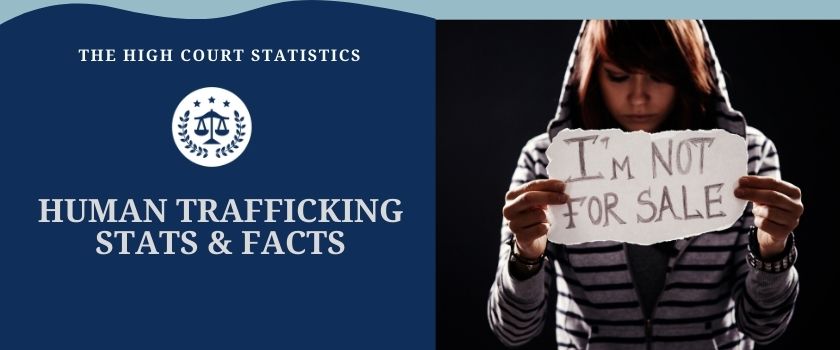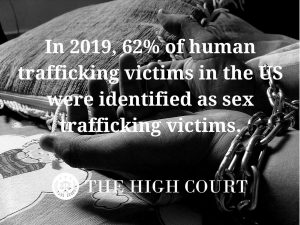
Did you know that July 30 is World Day against Trafficking in Persons? It underlines global efforts to eradicate this horrible crime that comes in many forms. Every year, thousands of children, women, and men are victims of trafficking, human trafficking statistics reveal.
The thing is:
People are trafficked for sexual exploitation, forced labor, forced begging, forced marriage, and more. Children are also sold as child sex slaves and child soldiers, while adults are trafficked for organ harvesting.
It gets worse:
Some of the most shocking facts about human trafficking are that women and girls make up a significant amount of the total number of trafficking victims. And the most common form of exploitation is sexual.
Victims are trafficked within their countries, but the Trafficking Victims Protection Act, passed in 2000, specifies that a victim doesn’t need to be physically transported from one location to another for the crime to fall within this definition.
Speaking of which:
When it comes to defining what is human trafficking, the US uses the terms “trafficking in persons,” “modern slavery,” and “human trafficking” interchangeably to refer to sex and labor trafficking.
Now that we have a clear human trafficking definition, let’s move on to the stats we’ve curated for you at The High Court.
Depressing Human Trafficking Facts (Editor’s Picks)
- 25 million people across the globe are denied their fundamental right to freedom.
- 30% of the global human trafficking victims are children.
- Women make up 49% of all victims of global trafficking.
- In 2019, 62% of victims in the US were identified as sex trafficking victims.
- In 2019, US Department of Health and Human Services (HHS) grantees reported 68% of clients served were victims of labor trafficking.
- Human traffickers face a maximum statutory penalty of 20 years in prison in the US.
- In France, 74% of exploited victims were victims of sex trafficking in 2018.
Human Trafficking in the United States
1. In 2019, 62% of victims in the US were identified as sex trafficking victims.
(Source: 2020 Trafficking in Persons Report, State.gov)
Now, let’s clearly define what is sex trafficking:
Sex trafficking is a form of human trafficking for the purposes of sexual exploitation. It includes sexual slavery, which is also considered modern slavery today.
According to the 2019 human trafficking statistics in the United States, there were 8,375 open victim cases reported. 5,090 of these were new.
62% of the victims were US citizens or permanent residents, and 35% were foreign nationals. The citizenship of 2% was unknown.
What’s more:
62% of the victims were identified as sex trafficking victims, 22% were victims of labor trafficking, and 7% were victims of both. The case for 9% was unknown.
2. In 2019, US Department of Health and Human Services (HHS) grantees reported 68% of clients served were victims of labor trafficking.
(Source: 2020 Trafficking in Persons Report)
Additionally, HHS grantees reported 20% of clients were victims of sex trafficking in the United States, and 12% were victims of both sex and labor trafficking.
The HHS earmarked $10.9 million for the provision of case management services to foreign national victims via NGOs in 2019.
3. In 2019, the HHS provided $2.3 million to address human trafficking in the child welfare system.
(Source: 2020 Trafficking in Persons Report)
As per the 2020 human trafficking statistics, $7 million were earmarked for administrative activities to serve any child or youth in the placement, care, or supervision of a foster care agency who was at risk of becoming a sex trafficking victim, identified as a sex trafficking victim, or was missing from foster care.
4. There is almost a 20% increase in human trafficking survivors and victims who contacted the trafficking hotline directly.
(Source: Polaris Project)
When those affected by trafficking reach out to the human trafficking hotline, they share valuable information. This enables better support in providing a safety plan, a shelter bed, finding an attorney, a trauma counselor, or even engaging law enforcement.
According to sex trafficking statistics from 2019, texting has become a more common method of reaching out to the trafficking hotline.
5. In 2019, the human trafficking hotline identified 22,326 survivors and victims.
(Source: Polaris Project)
The vast majority of trafficking victims and survivors the human trafficking hotline identified were victims and survivors of sex trafficking (14,597). They were followed by victims of labor trafficking (4,934) and sex and labor (1,048), with 1,747 unspecified.
6. Escort services are the top sex trafficking type, with 1,278 identified cases.
(Source: Polaris Project)
Escort services are followed by forced commercial sex and labor service as part of the illicit massage, health, and beauty sector (1,274), and pornography (733). There are different types of human trafficking cases of both sex and labor trafficking. The top three identified labor trafficking types are domestic work, with 218 victims, agriculture, and animal husbandry (108), and traveling sales crews (107).
7. Job offer/advertisement is the most common recruitment tactic for labor trafficking, with 2,557 identified cases.
(Source: Polaris Project)
Human traffickers use different tactics to recruit victims. The most common sex trafficking recruitment tactics are intimate partner/marriage proposition, job offer or advertisement, and false promises. Similarly, the most common recruitment tactics for labor trafficking are job offers, fraud, and smuggling related tactics.
8. One in eight endangered runaway youths is likely to be the victim of human trafficking.
(Source: NHTH, MissingKids)
Human sex trafficking statistics show some children are more vulnerable when it comes to human trafficking. This includes missing or runaway children but also those who have experienced sexual abuse, assault, or rape, those who have substance abuse issues, and those who identify as LGBTQ and have been either stigmatized by their family or kicked out of the home.
Human Trafficking Statistics Worldwide
9. 25 million people are denied their fundamental right to freedom.
(Source: 2020 Trafficking in Persons Report)
The history of human trafficking is a long and tragic one. The Trafficking in Persons Report provides governments with invaluable data to prosecute traffickers and provide victim-centered and trauma-informed protection for the victims. The ultimate goal, of course, is to eradicate this dreadful crime altogether.
The report, which marked its 20th-anniversary edition in 2020, includes the most important forced labor and sex trafficking 2020 stats.
With that in mind, let’s take a look at the current state of how human trafficking in different parts of the world.
10. Traffickers exploit 70% of the estimated five million Ethiopians transported to Saudi Arabia in forced labor, prostitution statistics reveal.
(Source: 2020 Trafficking in Persons Report)
Labor and sex trafficking facts are clear:
Traffickers exploit over two-thirds of Ethiopians transported to Saudi Arabia for forced labor. Young women mostly travel through Eritrea or Djibouti to look for domestic work in Saudi Arabia.
[bctt tweet=”Altogether, about 400,000-500,000 Ethiopians reside in Saudi Arabia with no valid travel documentation, which significantly increases their vulnerability to forced labor or sex trafficking exploitation.” via=”no”]
11. International organizations estimated 93% of child labor in Bangladesh, including forced child labor, is in the informal sector.
(Source: 2020 Trafficking in Persons Report, DOL)
Inspectors filed 42 cases on the worst forms of child trafficking against employers, especially child labor. Unfortunately, slavery facts show the Bangladeshi Government made only moderate progress in the efforts to combat and eradicate the worst forms of child labor in 2019.
Here are the figures:
In 2019, more than 1,000 working children from 558 factories were removed, and 3,501 children were rehabilitated. Since 2017, 90,000 children have been removed from hazardous labor conditions, and over 35,000 children from exploitative work.
12. The government of Argentina reported that it had implemented 59% of the national anti-trafficking action plan, human trafficking statistics for 2020 confirm.
(Source: Human Rights Watch, 2020 Trafficking in Persons Report)
However, a specific budget for the plan is yet to be allocated. That’s why observers have raised concerns about the government’s ability to fund the anti-trafficking programs.
In contrast to the previous reporting periods, the Argentine Government did not report the latest human trafficking info or any details of its efforts to combat labor trafficking in 2019.
13. In France, 74% of exploited victims were victims of sex trafficking in 2018.
(Source: 2020 Trafficking in Persons Report)
Unfortunately, the hit 2008 action-thriller movie Taken is not pure fantasy – sex trafficking is a problem in France.
Forced labor (17%), forced criminality (5%), and forced begging (3%) followed. In terms of origin, 48% of respondents came from Nigeria. North Africa and Eastern Europe were also not uncommon regions of origin.
And that’s not all:
Of the 50,000 people involved in commercial sex in France, about 90% are foreign and likely trafficking victims. In fact, France assisted fewer victims in 2019 than it did in 2018. The police identified 892 victims of exploitation. The corresponding figure for 2018 stood at 950.
Out of all the exploited victims in 2019, 175 were victims of trafficking, and 717 were victims of aggravated sexual exploitation. Some cases included victims of adult and child sexual slavery.
Victim Demographics
14. 30% of trafficking victims are children.
(Source: 2020 Trafficking in Persons Report, UN)
The crime of human trafficking is happening all around us. And unfortunately, nearly one-third of the victims are children. They are subject to different forms of abuse, including forced labor and sexual exploitation, child sex trafficking statistics reveal.
15. Women make up 49% of all trafficking victims.
(Source: UN)
Additionally, girls make up 23% of the total number. Sexual exploitation has a global share of 59%, followed by forced labor (34%).
In the past 15 years, women and girls together represent more than 70% of the identified trafficking victims.
16. Men make up 21% of the identified victims of trafficking in persons, human trafficking statistics confirm.
(Source: UNODC)
Of that 30% of children victims of human trafficking, more girls were identified. Boys represented 7% of the total number of trafficking in person victims globally.
Half of the boys (50%) were victims of forced labor.
On the other hand, the vast majority of girls were sex trafficking victims (72%). Lastly, the vast majority of men (82%) were forced labor trafficking victims.
Human Trafficking Stats about Perpetrators
17. More than 35% of those prosecuted for trafficking in persons were women.
(Source: UNODC)
Studies show that women are more engaged in the human trafficking recruitment phase.
Statistics on human trafficking further reveal 31% of the persons investigated or arrested for this crime in 2016 or more recently were women, and 69% were men.
About 65% of the prosecuted perpetrators were men. Lastly, 38% of the perpetrators who were convicted were women and 62% were men.
18. 70% of the convicted perpetrators were local nationals.
(Source: UNODC)
On the other hand, about one-third of those convicted were foreign traffickers (30%). Additionally, 21% of the foreign perpetrators were from the same region, whereas 9% were from outside the region.
19. In the US, perpetrators face a maximum statutory penalty of 20 years in prison for the sex trafficking of adults, human trafficking statistics confirm.
(Source: UCHasting)
The prison sentence for labor trafficking crimes is up to 12 years per offense. On the other hand, perpetrators may get up to 20 years per offense for the sex trafficking of adults. Child sex trafficking that includes force or fraud is punishable by up to a life term in prison.
In addition to time behind bars, perpetrators face considerable fines:
20. Human traffickers face fines of up to $1,500,000.
(Source: UCHasting)
As per the same approved propositions, the fines for sex trafficking of a minor in the US are up to $100,000.
Human trafficking facts reveal 70% of the funds obtained from fines are allocated to public agencies and organizations that provide support to human trafficking victims.
The remaining 30% of the collected fines by the perpetrators are allocated to law prosecution and enforcement agencies and utilized for prevention, rescue operations, and witness protection.
Final Words
Human trafficking is a despicable global crime that needs to be eradicated.
The good news is:
In the latest reporting period for human trafficking statistics in 2021 by state in the US and globally, there have been some improvements in combating these crimes and in providing greater support to the victims.
However:
Child trafficking statistics show the crime is still prevalent among the most vulnerable, and the numbers of sex trafficking victims remain quite shocking. Clearly, governments and NGOs need to double their efforts in the struggle against human trafficking.
FAQ
Q: What is the #1 state for human trafficking?
According to human trafficking statistics from 2019, the state that constantly has the highest rates in human trafficking is California, with 1,507 reported cases in 2019. 1,118 of these cases involved sex trafficking, 158 labor trafficking, and 69 both. The remaining cases weren’t specified. Out of the reported victims, 1,290 were female, 149 were male, and 10 were gender minorities.
Even though there is a misconception that human trafficking doesn’t happen in the United States, there are in fact 199,000 incidents every year.
Q: What are the top 3 states for human trafficking?
The human trafficking articles suggest California. The Golden State is followed by Texas, Florida, and New York. In 2019, there were 1,080 cases in the Lone Star State, 896 cases in the Sunshine State, and 454 cases in the Empire State.
Q: What are the top 10 cities for human trafficking?
According to the latest human trafficking statistics, the top cities in the US are:
-
Huston
-
Los Angeles
-
New York
-
Washington, DC
-
Chicago
-
Las Vegas
-
Atalanta
-
Dallas
-
Miami
-
Columbus
Q: Which country has the highest rate of human trafficking?
According to human trafficking statistics from 2018, the top three nations of origin of trafficking victims were the United States, Mexico, and the Philippines.
Sources:



